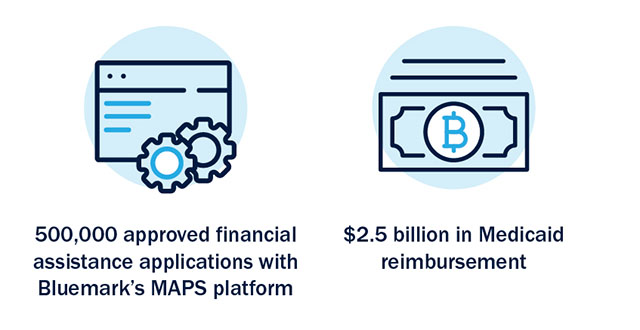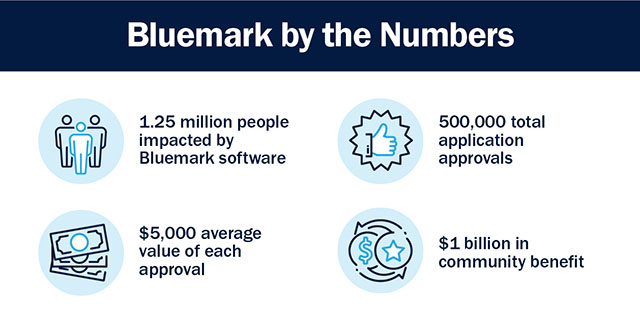
In the world of healthcare financial software, we tend to default to speaking in terms of efficiency, productivity and dollars. After all, that’s our business model. We help hospitals screen more patients, cover more medical bills and use technology to form long-term relationships with patients. It’s easy to illustrate this in terms of dollars, percentages and decimal points.
But what if we told you that screening more patients and connecting them with available benefits can build strong communities? Or that covering one emergency room visit with Medicaid can change someone’s life? When you put people at the forefront of the equation, the healthcare software industry is seen in an entirely new light.
The business of healthcare software
At Bluemark, our software’s inherent value lies in making sure that individuals are connected to the right programs at the right time, making sure no one falls through the cracks and that hospitals can screen and enroll as many folks as possible. While getting screened for financial assistance provides an inherent benefit to the patient (we’ll get to this in a moment), increased screening and program enrollment also has a significant impact in a hospital revenue setting that should not be overlooked.
Since our company was founded, our clients have utilized the MAPS platform to secure Medicaid approval for over 500,000 applications. Projecting forward we see that number growing by 100,000 plus approvals per year.

Our clients have also utilized the MAPS platform to approve over 500,000 in financial assistance applications. The Medicaid approvals have resulted in $2.5 billion in Medicaid reimbursement for our clients.
Over the years, we, like many of our peers, have found ourselves defaulting to the business approach to tell our story. We’ve focused on the what and how, but too often overlooked our why – and it’s a shame, because the “why” is so powerful.
The “why” of healthcare software
If you sift through the numbers, data and billing statements, there’s another side of the coin,which is the side that makes us and our peers in the industry want to get up in the morning and go to work: our impact on patients. With healthcare financial assistance software hospitals receive critical revenue, but a patient walks away enrolled in Medicaid or another type of financial assistance program. What does that mean?
Sometimes it means an entire family gets the healthcare they need on a regular basis. Other times it means someone who has lived in chronic pain for decades is able to afford the medication they need for relief. For some people, Medicaid programs allow for an independent lifestyle with open access to regular medical care.
Hospitals operate with basic business principles in mind, but they are not a business in the traditional sense. Hospitals aren’t just driven by revenue, they’re driven by their mission statements and core values. Helping the community is part of that mission.
What does Medicaid access mean for communities?
In the United States, one out of every five adult patients and one in three children receives health insurance through Medicaid. These patients are diverse in age, ethnicity and health, but all are able to receive the care they need without the burden of cost.
Medicaid especially protects middle-class families, children, the disabled community and senior citizens. In fact, 70% of nursing home residents pay through Medicaid. Medicaid and other financial assistance programs don’t just protect the most vulnerable among us, either. Anyone can find themselves in a situation where the cost of necessary medical care seems overwhelming or impossible.
Financial assistance programs create healthy communities inhabited by people with proper access to care. It also helps hospitals keep up with expenses and strengthens the healthcare system for everyone by reducing the burden of cost and avoiding resource shortages.
The individual impact of financial assistance
If you have been fortunate enough to be able to afford medical care throughout your life, it can be difficult to truly understand the impact these programs have on both individual people and our communities as a whole.
There are countless stories from people who could be your friends, neighbors and peers who have benefited from financial assistance. Consider John from New York City, who left an abusive household at age 14 and enrolled in Medicaid after moving into a homeless shelter. Later in life, after working his way to a steady career and his own apartment, he was suddenly diagnosed with HIV, medication for which cost upwards of $4,000 per month.
Today, John is enrolled in Medicaid for his HIV as well as management for his diabetes, heart issues and lupus. With the burden of these costs handled, he is able to donate his time to an AIDS support organization while keeping his home.
Tom from Dayton, Ohio had a six-figure salary and job security before losing his sister and parents within the span of 16 days and suffering from a mental health crisis. Tom found himself homeless, jobless and in need of mental health treatment with no insurance. With Medicaid, Tom was able to get the help he needed and move back into his own apartment.
In Tom’s words, “Because of Medicaid, for the first time in 20 years, I am happy.” These are just two of thousands of stories from individuals across the U.S. whose lives have been changed by the impact of financial assistance. You can read more stories from your state and beyond from the Robert Johnson Wood Foundation
Quantifying the “why” of healthcare software
Of course, just because the “why” behind what we do can best be told in stories, that doesn’t mean we can’t quantify it the same way we can quantify our impact.

Since its founding in 2001, Bluemark solutions have facilitated the approval of over 500,000 applications impacting 1.25 million people. Recall that Medicaid benefits extend to the patient’s entire family after approval. The average size of families eligible for Medicaid due to these approvals is 2.5 people, meaning our impact goes two-and-a-half times further on average.
Further, the average value of each approval is $5,000. Crunching the numbers, it can be conservatively estimated that our financial assistance efforts have generated over $1 billion in reimbursement revenue and community benefit.
Bluemark: Supporting communities nationwide
Over the years, we’ve focused on our core offering of healthcare financial assistance software, but we’ve also worked outside hospital walls with nonprofits on a mission to connect underinsured or uninsured families with public benefits. We’ve created a software platform designed to link working class families with food assistance programs.
Inside hospital walls, we’ve also created specific tools designed to benefit patients, including our MAPS-clear Patient Outreach Portal, which makes it simple for patients to connect with healthcare financial professionals online and submit documentation needed to push them through the application process. This software benefits both the hospital, which sees a reduced workflow, but also the patient, who receives a partial or full discount on their medical bills.
Our mission as a company goes beyond revenue and dollar signs. What we do is ultimately about helping the patients that need high-quality care. We have worked and will continue to work to strengthen the health of communities across the country.
Go beyond revenue and support your hospital’s mission by bringing patients back into the equation. Learn more about Bluemark’s patient-centric software tools like MAPS-Clear here.




